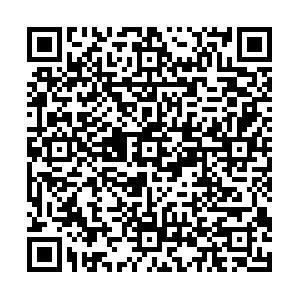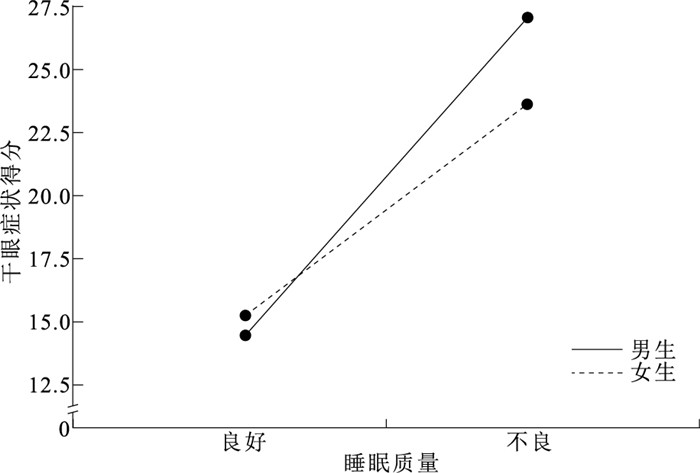Association between sleep quality and dry eye symptoms among adolescents
-
摘要:
目的 探索青少年睡眠质量和干眼症状之间的关联,为降低青少年干眼症状患病率提供参考。 方法 研究对象为来自中国居民心理与行为调查(PBICR)的12~24岁青少年,于2022年6月20日—8月31日,采用分层随机与配额抽样相结合的方法在中国大陆范围选取6 456名青少年,并对其使用眼表疾病指数(OSDI)和简版匹兹堡睡眠质量指数(B-PSQI)评估干眼症状和睡眠质量。应用多元Logistic回归模型探索睡眠质量与青少年干眼症状之间的关系,利用交互项探讨性别对关联的影响。 结果 共有2 815名青少年报告存在干眼症状,报告率为43.6%。Logistic回归分析结果显示,睡眠质量不良的青少年干眼症状加重的风险增加,与睡眠质量良好组相比,睡眠质量不良组轻度、中度和重度干眼症状的OR值(95%CI)分别为1.39(1.16~1.67),1.52(1.28~1.81),2.35(2.02 ~2.72)(P值均 < 0.05)。睡眠质量和性别对青少年干眼症状的交互作用有统计学意义(P < 0.01)。 结论 睡眠质量与青少年干眼症状之间存在关联,睡眠质量不良者干眼症状加重的风险更高,其影响在男生中更大。 Abstract:Objective To explore the association between sleep quality and dry eye symptoms in adolescents, so as to provide the evidence for reducing the prevalence of dry eye symptoms. Methods The study population was adolescents aged 12-24 years from the Psychology and Behavior Investigation of Chinese Residents (PBICR) survey, which was conducted from 20 June to 31 August 2022. A stratified random sampling and quota sampling method was used to select 6 456 adolescents within mainland China. The Ocular Surface Disease Index (OSDI) and Brief version of the Pittsburgh Sleep Quality Index (B-PSQI) were used to assess dry eye symptoms and sleep quality. Multiple Logistic regression model was used to explore the relationship between sleep quality and dry eye symptoms in adolescents. The influence of gender on the association was explored by using interaction terms. Results A total of 2 815 adolescents reported having dry eye symptoms, with a prevalence of 43.6%. Logistic regression analysis results showed an increased risk of exacerbation of dry eye symptoms in adolescents with poor sleep quality. The OR(95%CI) for mild, moderate, and severe dry eye symptoms groups were 1.39(1.16-1.67), 1.52(1.28-1.81), and 2.35(2.02-2.72), respectively, compared with the ocularly normal group (P < 0.05). There was a significant interaction between sleep quality and gender on dry eye symptoms in adolescents (P < 0.01). Conclusions Sleep quality is associated with dry eye symptoms in adolescents, and those with poor sleep quality have a higher risk of dry eye symptoms. The effect of sleep quality on dry eye symptoms is greater in boys. -
Key words:
- Sleep /
- Xerophthalmia /
- Regression analysis /
- Adolescent
1) 利益冲突声明 所有作者声明无利益冲突。 -
表 1 青少年不同程度干眼症状报告率单因素分析
Table 1. Univariate analysis of the report rates of different degrees of dry eye symptoms in adolescents
因素 选项 人数 轻度 中度 重度 χ2/H值 P值 年龄/岁 12~15 1 058 121(11.4) 96(9.1) 164(15.5) 22.92 < 0.01 16~19 3 320 447(13.5) 405(12.2) 652(19.6) 20~24 2 078 223(10.7) 305(14.7) 402(19.3) 性别 男 3 196 316(9.9) 377(11.8) 647(20.2) 33.64 < 0.01 女 3 260 475(14.6) 429(13.2) 571(17.5) 眼科相关疾病 是 4 080 616(15.1) 546(13.4) 778(19.1) 74.98 < 0.01 否 2 376 175(7.4) 260(10.9) 440(18.5) 慢性病 是 620 90(14.5) 110(17.7) 162(26.1) 11.58 < 0.01 否 5 836 701(12.0) 696(11.9) 1 056(18.1) 易感疲劳 是 3 623 478(13.2) 518(14.3) 842(23.2) 681.74 < 0.01 否 2 833 313(11.0) 288(10.2) 376(13.3) 平均每周参与体育活动天数/d 0~3 5 144 630(12.2) 641(12.5) 949(18.4) 19.01 < 0.01 4~7 1 312 161(12.3) 165(12.6) 269(20.5) 平均每天入睡前使用智能手机时长/h ≤1 3 896 469(12.0) 478(12.3) 725(18.6) 1.63 0.65 >1 2 560 322(12.6) 328(12.8) 493(19.3) 经济分区 东部 2 578 339(13.1) 312(12.1) 485(18.8) 4.26 0.64 中部 2 184 247(11.3) 274(12.5) 412(18.9) 西部 1 694 205(12.1) 220(13.0) 321(18.9) 睡眠质量 良好 4 687 556(11.9) 540(11.5) 669(14.3) 127.11 < 0.01 不良 1 769 235(13.3) 266(15.0) 549(31.0) 注: ()内数字为报告率/%。 表 2 睡眠质量与青少年干眼症状关联的多因素Logistic回归模型[OR值(95%CI),n=6 456]
Table 2. Multivariate Logistic regression model for the association between sleep quality and dry eye symptoms in adolescents [OR(95%CI), n=6 456]
模型 睡眠质量 轻度 中度 重度 模型1 良好 1.00 1.00 1.00 不良 1.72(1.45~2.04) 2.00(1.69~2.37) 3.34(2.90~3.83) 模型2 良好 1.00 1.00 1.00 不良 1.39(1.16~1.67) 1.52(1.28~1.81) 2.35(2.02~2.72) 注: P值均<0.01;模型1为未校正混杂因素,模型2为校正了性别、年龄、眼科相关疾病、慢性病、易感疲劳、平均每周参与体育活动天数等混杂因素。 -
[1] CRAIG J P, NICHOLS K K, AKPEK E K, et al. TFOS DEWS Ⅱ definition and classification report[J]. Ocul Surf, 2017, 15(3): 276-283. doi: 10.1016/j.jtos.2017.05.008 [2] LIN F, CAI Y, FEI X, et al. Prevalence of dry eye disease among Chinese high school students during the COVID-19 outbreak[J]. BMC Ophthalmol, 2022, 22(1): 190. doi: 10.1186/s12886-022-02408-9 [3] ZHANG S, HONG J. Risk factors for dry eye in mainland China: a multi-center cross-sectional hospital-based study[J]. Ophthalmic Epidemiol, 2019, 26(6): 393-399. doi: 10.1080/09286586.2019.1632905 [4] 韦振宇, 刘含若, 梁庆丰. 我国干眼流行病学的研究进展[J]. 中华眼科医学杂志(电子版), 2020, 10(1): 46-50.WEI Z Y, LIU H R, LIANG Q F. Advances on the epidemiology of the dry eye[J]. Chin J Ophthalmol Med(Electr Edit), 2020, 10(1): 46-50. (in Chinese) [5] LIN F, CAI Y, FEI X, et al. Prevalence of dry eye disease among Chinese high school students during the COVID-19 outbreak[J]. BMC Ophthalmol, 2022, 22(1): 190. doi: 10.1186/s12886-022-02408-9 [6] 金子群, 李从心, 温莹. 生活方式与儿童干眼相关性的研究进展[J]. 国际眼科杂志, 2023, 23(9): 1503-1506.JIN Z Q, LI C X, WEN Y. Research progress on the relationship between lifestyle and dry eye in children[J]. Int Eye Sci, 2023, 23(9): 1503-1506. (in Chinese) [7] WANG N, ZHUANG X, ZHONG X, et al. Questionnaire analysis on incidence and risk factors of dry eye in children from a myopia outpatient clinic[J]. Front Med (Lausanne), 2022(9): 846709. [8] 张文娟, 许智超, 王佳, 等. 军医大学学生干眼现状及相关因素分析[J]. 解放军护理杂志, 2020, 37(5): 69-72.ZHANG W J, XU Z C, WANG J, et al. Xerophthalmia of students in military medical university and its influencing factors[J]. Nurs J Chin PLA, 2020, 37(5): 69-72. (in Chinese) [9] KAWASHIMA M, UCHINO M, YOKOI N, et al. The association of sleep quality with dry eye disease: the Osaka study[J]. Clin Ophthalmol, 2016, 10: 1015-1021. [10] GALOR A, SEIDEN B E, PARK J J, et al. The association of dry eye symptom severity and comorbid insomnia in US Veterans[J]. Eye Contact Lens, 2018, 44(Suppl 1): S118-S124. [11] HE Q, CHEN Z, XIE C, et al. The association between dry eye disease with depression, anxiety and sleep disturbance during COVID-19[J]. Front Psychiatry, 2022, 12: 802302. doi: 10.3389/fpsyt.2021.802302 [12] 罗玉竹, 陶舒曼. 儿童青少年生活方式相关性干眼的研究进展[J]. 中国学校卫生, 2024, 45(3): 443-447. doi: 10.16835/j.cnki.1000-9817.2024071LUO Y Z, TAO S M. Research progress on lifestyle-related dry eye in children and adolescents[J]. Chin J Sch Health, 2024, 45(3): 443-447. (in Chinese) doi: 10.16835/j.cnki.1000-9817.2024071 [13] KARACA E E, AKÇAM H T, UZUN F, et al. Evaluation of ocular surface health in patients with obstructive sleep apnea syndrome[J]. Turk J Ophthalmol, 2016, 46(3): 104-108. doi: 10.4274/tjo.57778 [14] 卢聪聪. 兰州市小学生干眼患病率及相关因素分析[D]. 兰州: 甘肃中医药大学, 2019.LU C C. Prevalence and related factors of dry eye in primary school pupils in Lanzhou[D]. Lanzhou: Gansu University of Chinese Medicine, 2019. (in Chinese) [15] WANG Y J, KAIERDEBIEKE A, FAN S Y, et al. Study protocol: a cross-sectional study on psychology and behavior investigation of Chinese residents, PBICR[J]. Psychosomat Med Res, 2022, 4(3): 19. doi: 10.53388/202219 [16] DONG X X, LI D L, MIAO Y F, et al. Prevalence of depressive symptoms and associated factors during the COVID-19 pandemic: a national-based study[J]. J Affect Disord, 2023, 333: 1-9. doi: 10.1016/j.jad.2023.04.034 [17] OZCURA F, AYDIN S, HELVACI M R. Ocular surface disease index for the diagnosis of dry eye syndrome[J]. Ocul Immunol Inflamm, 2007, 15(5): 389-393. doi: 10.1080/09273940701486803 [18] 林晨, 杨敏敏, 郑虔. 眼表疾病指数量表中文版的研制和性能评价[J]. 眼科新进展, 2013, 33(1): 38-40.LIN C, YANG M M, ZHENG Q. Development and evaluation of Chinese version Questionnaires of Ocular Surface Disease Index[J]. Recent Adv Ophthalmol, 2013, 33(1): 38-40. (in Chinese) [19] SCHIFFMAN R M, CHRISTIANSON M D, JACOBSEN G, et al. Reliability and validity of the Ocular Surface Disease Index[J]. Arch Ophthalmol, 2000, 118(5): 615-621. doi: 10.1001/archopht.118.5.615 [20] SANCHO-DOMINGO C, CARBALLO J L, COLOMA-CARMONA A, et al. Brief version of the Pittsburgh Sleep Quality Index (B-PSQI) and measurement invariance across gender and age in a population-based sample[J]. Psychol Assess, 2021, 33(2): 111-121. doi: 10.1037/pas0000959 [21] ASIEDU K, KYEI S, BOAMPONG F, et al. Symptomatic dry eye and its associated factors: a study of university undergraduate students in Ghana[J]. Eye Contact Lens, 2017, 43(4): 262-266. doi: 10.1097/ICL.0000000000000256 [22] YAN C, LI A, HAO Y, et al. The relationship between circadian typology and dry eye symptoms in Chinese college students[J]. Nat Sci Sleep, 2022, 14: 1919-1925. doi: 10.2147/NSS.S378612 [23] WOLFFSOHN J S, WANG M T M, VIDAL-ROHR M, et al. Demographic and lifestyle risk factors of dry eye disease subtypes: a cross-sectional study[J]. Ocul Surf, 2021, 21: 58-63. doi: 10.1016/j.jtos.2021.05.001 [24] CHEN X, ZHOU Y, GAO X, et al. Prevalence of symptomatic dry eye and influencing factors among Chinese adolescents: a cross-sectional study[J]. PLoS One, 2024, 19(10): e0312725. doi: 10.1371/journal.pone.0312725 [25] HANYUDA A, SAWADA N, UCHINO M, et al. Relationship between unhealthy sleep status and dry eye symptoms in a Japanese population: the JPHC-NEXT study[J]. Ocul Surf, 2021, 21: 306-312. doi: 10.1016/j.jtos.2021.04.001 [26] LEE Y B, KOH J W, HYON J Y, et al. Sleep deprivation reduces tear secretion and impairs the tear film[J]. Invest Ophthalmol Vis Sci, 2014, 55(6): 3525-3531. doi: 10.1167/iovs.14-13881 [27] LEMP M A, BAUDOVIN C, BADM J, et al. The definition and classification of dry eye disease: report of the definition and classification subcommittee of the international dry eye WorkShop (2007)[J]. Ocul Surf, 2007, 5(2): 75-92. doi: 10.1016/S1542-0124(12)70081-2 [28] BLAIR L M, PORTER K, LEBLEBICIOGLU B, et al. Poor sleep quality and associated inflammation predict preterm birth: heightened risk among African Americans[J]. Sleep, 2015, 38(8): 1259-1267. doi: 10.5665/sleep.4904 [29] 赵丁梦, 杨嘉玮, 朱思泉. 干眼与睡眠障碍关系的研究进展[J]. 国际眼科杂志, 2021, 21(5): 814-817.ZHAO D M, YANG J W, ZHU S Q. Research progress on the relationship between dry eye and sleep deprivation[J]. Int Eye Sci, 2021, 21(5): 814-817. (in Chinese) [30] HAN K T, NAM J H, PARK E C. Do sleep disorders positively correlate with dry eye syndrome? Results of national claim data[J]. Int J Environ Res Public Health, 2019, 16(5): 878. doi: 10.3390/ijerph16050878 [31] MAGNO M S, UTHEIM T P, SNIEDER H, et al. The relationship between dry eye and sleep quality[J]. Ocul Surf, 2021, 20: 13-19. doi: 10.1016/j.jtos.2020.12.009 [32] ZHENG Q, LI S, WEN F, et al. The association between sleep disorders and incidence of dry eye disease in Ningbo: data from an integrated health care network[J]. Front Med (Lausanne), 2022, 9: 832851. [33] 黄桦, 邹文进. 视频显示终端使用时间及睡眠时间与儿童干眼的关系[J]. 广东医学, 2018, 39(5): 701-704, 709.HUANG H, ZOU W J. A study on the correlaions between time of using VDT or sleeping time and dry eye in children[J]. Guangdong Med J, 2018, 39(5): 701-704, 709. (in Chinese) [34] HAN S B, YANG H K, HYON J Y, et al. Children with dry eye type conditions may report less severe symptoms than adult patients[J]. Graefes Arch Clin Exp Ophthalmol, 2013, 251(3): 791-796. doi: 10.1007/s00417-012-2097-2 -







 下载:
下载:

